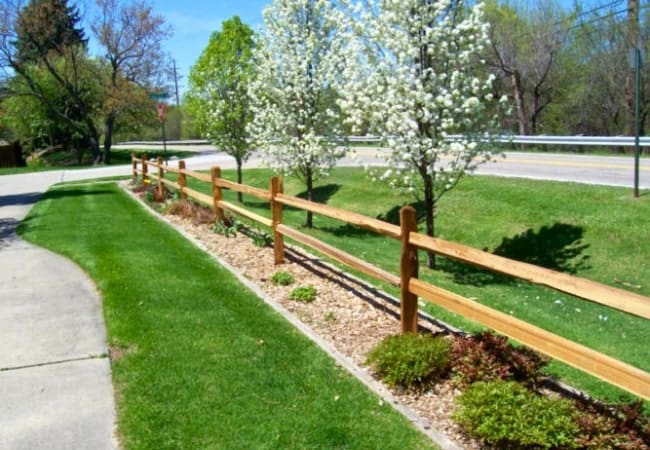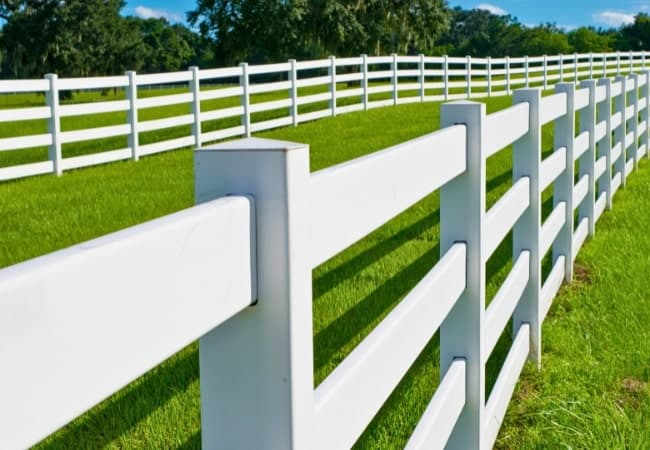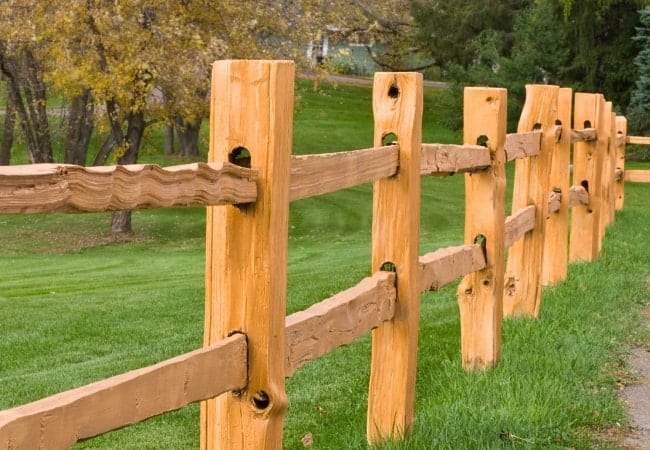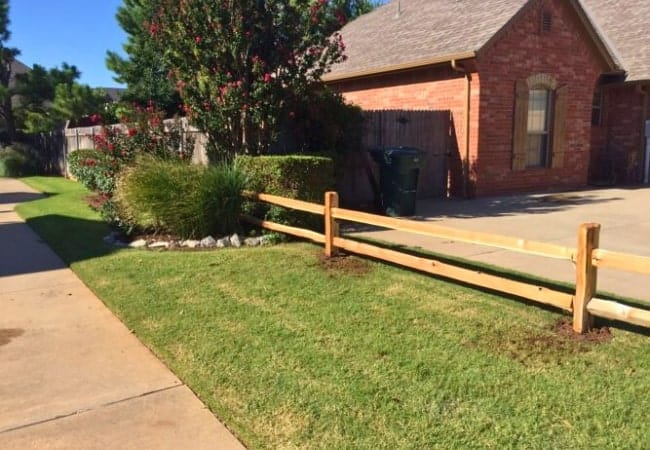Horse Fence Installed By Fence OKC
Fence OKC offers a wide range of customizable horse fences. Whether you own a farm or ranch and need to keep livestock contained or need to set property borders, horse fences are a great style to consider.
We offer wood and vinyl ranch rail fencing in various colors and stains. You can choose between the standard two-, three-rail, and four-rail horse fence design. Or you can call us today to see how to customize a horse fence to meet your needs.
So whether you’re looking for a livestock fence, farm fence, livestock fence, ranch fence, cattle fence, equine fence, split rail fence, or any other heavy-duty custom-built fencing for large areas of property, our horse fencing is most likely the best fit for you.
Fence OKC offers a variety of horse fence heights, types, styles, sizes, and hardware options. Request your free horse fence estimate today!
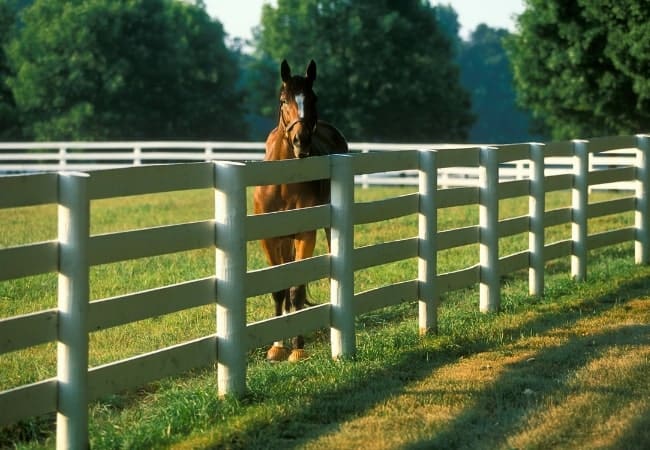
Selecting a Fence for Horses
Pastoral life scenes in the country often include beautiful horses running with tails raised high or peacefully grazing in lush green pastures surrounded by a freshly painted fence.
Not only are these fences lovely, but they also serve practical purposes. Fences are necessary to safely confine horses to your property yet allow them to graze and exercise. Because of the natural flight response, horses tend to injure themselves in fences more than most traditional livestock.
Schedule a free estimate
Fence OKC estimates are always free.
In addition, many horses are precious, which justifies the extra cost of building a safe, robust, attractive fence. Painted wooden rail fences are not only beautiful to humans, they are obvious and stand out to horses.
They appear to a horse as a solid barrier they are less likely to challenge, charge, or run into. When a horse does contact a rail fence, it is less likely to get a hoof hung or cut itself on sharp wire ends, as might be the case with many standard farm wire fences.
When selecting a horse fence, consider all three essential functions — safety, utility (keeping the horses in), and aesthetics. How much importance is placed on each function depends on the owner’s budget, the value of the animals, and your priorities. Several fence alternatives are available for consideration.
Popular Horse Fence Heights
Livestock fence heights do not necessarily apply to horses. Horses are more likely to jump a fence than to go under or through it when spooked.
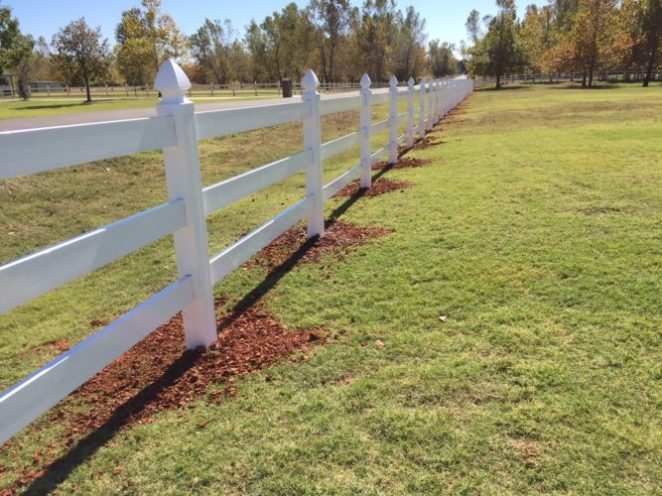
The minimum recommended height for a perimeter horse fence is 5 feet (60 inches). This height will deter most horses from jumping and reduce the temptation for people to reach over the fence to pet or feed horses. A 5-foot minimum height fence is both people-safe and horse-safe.
For corrals, stallion pens, and paddocks (small pastures or turn-out areas fewer than 2 acres in size), a general rule is that the top of the fence should be at eye level with the horse’s head in a natural upright position.
This is usually 4 to 6 inches above the horse’s withers. This height will prevent horses from leaning over the fence and discourage fighting to get over the fence, although the sure way to eliminate leaning and rubbing on any fence is to add an electric fence wire.
Fences that divide pastures can be 4.5 feet (54 inches) high. The bottom of the fence should be 6 to 8 inches off the ground.
This is especially important with wire mesh fences since horses are less likely to paw at the fence and more likely to keep the fence line grazed. In addition, weed growth is easier to control along the fence line by applying herbicides or using a weed-eater if this clearance is left below the bottom.
This technique also adds 6 inches of height to the fence at no extra cost.
Instant fence quote
Draw your fence online and get an instant estimate.
Central Oklahoma Fence Types for Horses & Livestock
Ensuring your horses’ and livestock’s safety and well-being in Central Oklahoma is paramount.
Proper fencing provides containment, defines boundaries, prevents unwanted guests, and offers peace of mind.
Discover which option best meets your ranching or farming needs.
Cedar Split Rail Fencing
One of the most popular rustic fence designs in central Oklahoma, strongly representative of the simple country life, split rail fencing is composed of just that: two or three divided rails inserted into two equally rough-finished wooden posts.
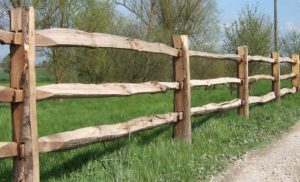 The posts are secured in the ground with or without concrete. Perhaps the most straightforward fence design is mainly used as a border fence to separate different areas aesthetically. This fence provides a defined division of areas without obstructing the view.
The posts are secured in the ground with or without concrete. Perhaps the most straightforward fence design is mainly used as a border fence to separate different areas aesthetically. This fence provides a defined division of areas without obstructing the view.
Advantages: These fences are generally the most affordable because they are simple in their design. They’re also easy to install and repair.
Modern split-rail fences are built in either wood or vinyl and can be used for decorative purposes. Vinyl fences are straightforward to clean, and wooden fences made from hardwoods are also durable when properly maintained.
Disadvantages: Although some options are affordable, the material used can also make split-rail fencing one of the more expensive options.
High-quality hardwoods will increase prices, and those heavy materials can also raise labor costs.
Wood materials also need regular treatment to prevent decay and deterioration. This type of fencing is open and loose, and small pets and children can easily escape through them.
Round Rail Fence
Round rail fencing is also a good option for more than just decorative purposes.
It works well with property owners who have livestock, including sheep, pigs, or horses. Because the third rail is closer to the ground than with two rail fences, smaller animals can be fenced in, as well.
It is common in central Oklahoma to see round rail fencing combined with wire mesh or chain link for additional security.
Of course, the bottom rail does not touch the ground, so trimming the grass below it is not a problem.
Vinyl Rail Horse Fencing
Vinyl rail horse fence, also called PVC fence, consists of hollow rails resembling traditional wooden rails. The rails snap into vinyl posts, making the fencing easy to install.
Appearance: Vinyl rail fencing is available in various colors and styles, so you can find the look that best suits your barn. Vinyl rail resembles wooden rail fencing, giving any property the classic appearance of a traditional horse farm.
Advantages: Vinyl rail is highly durable and virtually maintenance-free. It is also very safe since it is visible and will give way under a strong impact. If a horse runs into the fencing, the vinyl rail fence will give without splintering, like a wooden fence would.
Disadvantages: Vinyl rail horse fencing is not indestructible, and rails can pop out of their fence posts if a horse leans against them heavily. It would help to pair a strand of electric fencing with your vinyl rail fence to prevent your horses from leaning against it.
No-Climb Fence
This type of fencing is called woven wire, field fence, or diamond weave fence.
NO-climb fencing features a strong wire that is woven in a grid. The grid has small openings that prevent a horse’s hoof from becoming caught.
The wire mesh creates a solid barrier and is run along a line of fence posts and a solid top fence line. It is common in Oklahoma for an electrical line to be installed on the fence to keep livestock and horses from leaning on the fence line.
Appearance: No-climb fencing presents a clean and desirable appearance. Using fence posts and a solid top fence line gives it a hint of the classic horse fencing appearance, while proper installation will result in straight, visually appealing fence lines.
Advantages: No-climb fencing creates a solid barrier between your horse and the outside area. One significant advantage of no-climb fencing is that other animals, like dogs or coyotes, cannot easily access the pasture. No-climb fencing features a tight weave with openings small enough to prevent a horse’s hoof from getting caught, making this a safe fencing option for horses.
Disadvantages: No-climb fencing requires regular maintenance and must be tightened seasonally to prevent gaps from forming. Additionally, you need to check the fence’s perimeter regularly to make sure that trees are not growing into and warping the fence. Installing no-climb fencing over uneven terrain can be a challenge, and no-climb fencing is best for straight lines on flat land.
Barbed Wire Fencing
Although barbed wire is not preferred for horses, it is one of the most economical options for fencing a large property with a permanent barrier.
Barbed wire is a single or dual strand with sharp barbs spaced every 4 to 5 inches. Barbed wire is designed to discourage animals from leaning against it since the sharp barbs create a painful result.
Appearance: Barbed wire does have a rustic appearance and looks right at home on a ranch. Barbed wire has little visibility; aside from the fence posts, it almost blends into the background.
Advantages: Barbed wire provides a solid barrier and makes a popular fencing choice for cattle. Its low cost means you can fence large areas for little when using barbed wire.
Disadvantages: Barbed wire is not safe fencing for horses. Its barbs can quickly tear into a horse’s thin skin, and the injuries can be devastating if a horse becomes tangled in barbed wire. Barbed wire has little visibility, meaning a horse’s chances of entangling in the fence are higher. Additionally, barbed wire requires regular maintenance to keep the fence tight.
Wooden Rail Fence
Your classic Oklahoma horse fence, wooden rail fencing, consists of wooden boards (typically 3 or 4 for horses and livestock) nailed into wooden fence posts. Post and rail wooden fencing is also used, in which the fence rails are inserted into holes in the posts. Most wooden fencing is pine since pine resists splintering.
It is expected to install hog wire or no climb fencing to a wooden rail fence for added protection against medium-sized animals from getting in or out of your property.
Appearance: Wooden rail fence tends to be the classic, picturesque fencing appearance that most horse owners desire. This fencing is versatile because it is visually suitable for a backyard barn or a much larger multimillion-dollar equine facility.
Advantages: The strong wooden rail fence creates a solid barrier between horse pastures and the surrounding area. Their beautiful appearance makes wooden rail fences a favored option for horse fencing. Wooden rail fencing can add value to a property and is the traditional choice for many barns.
Disadvantages: Wooden rail fencing is expensive and also requires regular ongoing maintenance. The fencing must be sanded, primed, and painted as it ages, and broken or splintered boards must be replaced. You should also check wooden fencing regularly to ensure nails haven’t worked loose and the fence posts are still secure. Wooden fencing, while strong, can also splinter and injure a horse if the horse runs into the fence.
Fence OKC
Oklahoma’s modern fence company.
Horse Fence Installation FAQs
See the answers to the most frequently asked questions about horse fence installation from our valued customers in Central Oklahoma.
What's the best fence material for horses?
The most recommended material is often vinyl or wooden rail fencing due to its visibility and safety features.
How tall should a horse fence be?
A standard height for most horse fences is around 4.5 to 5 feet.
Can I install a horse fence myself?
While it’s possible, hiring professionals ensure the fence’s safety and durability, especially given the specific needs of horse fencing.
Is barbed wire safe for horse fencing?
No. Barbed wire can cause severe injuries to horses and is not recommended.
How much space is between fence posts?
Typically, posts are spaced 8 to 12 feet apart, depending on the type of fence and terrain.
How do I prevent my horse from leaning on the fence?
A hot wire or electric fence tape on top can deter horses from leaning or chewing on the fence.
Custom Livestock Fence Installation OKC
We can help you design and build exactly what you’re looking for. There are no limits to the fence we can create for you.
Contact us online for a free Fence OKC estimate, or give us a call at 1-405-778-1545 to set up a time for a free consultation. We look forward to serving you.
Check out our residential fence services page for some other Oklahoma Fence Ideas.

INSTANT FENCE QUOTE
Use our online fence designer to get a free instant fence quote.
Horse Fence Installation in Oklahoma
Our horse fence installers aren’t just skilled technicians—they’re artists with their craft.
TESTIMONIALS
WHAT PEOPLE SAY
We could say more to persuade you to choose Fence OKC, but we’d prefer to let our happy clients do the talking.
“Choosing Fence OKC was the best decision for our livestock. Professional, timely, and reliable!”
“From consultation to installation, everything was handled with utmost care. Can’t recommend Fence OKC enough.”
“Their reputation precedes them, and they certainly lived up to it with my fence installation.”
WHAT WE DO
OTHER RESIDENTIAL FENCE SERVICES
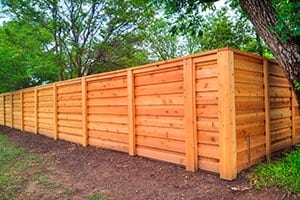
Cedar Privacy Fence
Cedar fencing is one of Oklahoma’s most common residential fence styles.
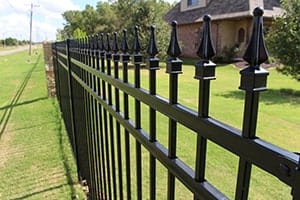
Iron Fencing
Aluminum, steel, and iron fence comes in different styles, colors, and grades.
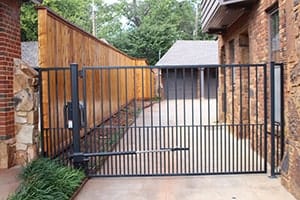
Automated Gates
Automated driveway gates are fabricated in our in-house welding shop located in OKC.
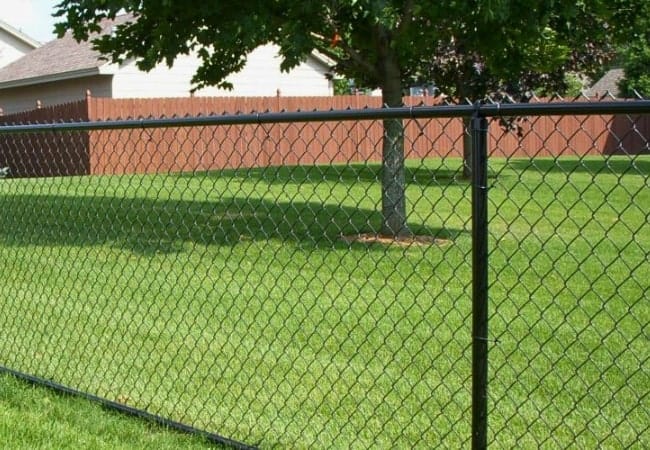
Chain Link Fencing
Chain link fence has an economical advantage over many other fence types.
Need Some Help?
Should you need help or have any inquiries, the team at Fence OKC stands ready to assist. We are dedicated to addressing all your fencing concerns in Oklahoma City, ensuring you choose the ideal fence for your needs.
OKLAHOMA CITY, OKLAHOMA
LOCATION AND SERVICE AREAS
Located in the heart of Oklahoma City, Fence OKC proudly serves a broad spectrum of areas, ensuring every corner of our community benefits from top-tier fencing solutions. We've got you covered whether you're near or a bit further out.

Fence OKC Service Areas
Edmond • Oklahoma City • Norman • El Reno • Moore • Yukon • Mustang • Piedmont • Guthrie • New Castle • Blanchard • Tuttle • Choctaw • Harrah • Nichols Hills • Arcadia • Jones • Newalla • Gallardia • Del City • Tulsa • Noble • Midwest City • Kingfisher • Stillwater • McCloud • Bristow • Sapulpa • Broken Arrow • Sand Springs • Owasso • Enid • Weatherford • Hinton • Elk City • Clinton • Woodward

